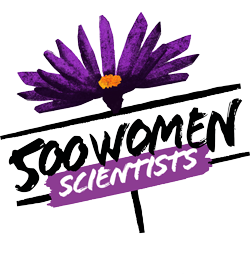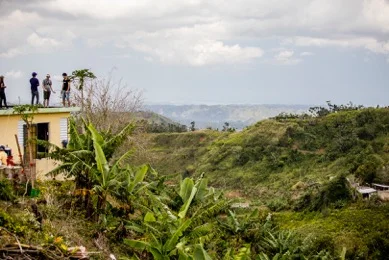This week on #MeetAScientist, learn about University of Washington Chemical Engineering professor Lilo Pozzo. Lilo's research group explores properties of nanomaterials with applications spanning from photovoltaic cells to protein engineering. Born in Argentina and raised in Puerto Rico, Dr. Pozzo recently spent time in Puerto Rico with her research group helping restore power to the island using microgrids and solar arrays, an effort recognized in a New York Times piece. Dr. Pozzo was recently awarded the UW College of Engineering faculty award for Teaching and Learning, and was honored at the Latinx Faculty Awards last year.
When did you first identify as a scientist? What does your research center on today?
It was sometime during the first year of graduate school that I first seriously identified myself as a scientist. During my undergraduate studies, I was fortunate to interact with excellent faculty at the University of Puerto Rico Mayaguez that provided outstanding examples of effective and passionate teaching. This cemented my drive to become a faculty member and seek an academic career in the future. This was, however, motivated primarily by a personal interest in teaching Chemical Engineering and not so much at that time for performing academic research. During my first year of graduate school at Carnegie Mellon, my thesis advisor exposed and trained me to work on rigorous academic research projects and I instantly loved the experience. I published my first paper shortly after this first year and I was ‘hooked’ ever since. I now love all aspects of my faculty job, namely teaching and research, equally.
Our group’s research today centers on controlling material properties and understanding how these arise in polymers and colloidal systems. ‘Colloids’ is a broad term encompassing most of nano materials but also including emulsions, foams, aerosols and larger particle dispersions. We use advanced techniques, such as neutron and x-ray scattering, to analyze material structures and to learn about how these relate to macroscopic properties. This knowledge then enables us to control properties by manipulating structure and we use this approach to solve engineering problems in many different areas. Currently, we are working on developing better contrast agents for medical imaging and therapy and also on synthesizing new materials for use in grid-scale energy storage technologies. As you see, the intended applications are very broad but the link between all of these projects is the fundamental understanding of material structure-property relationships.
You recently spent time in Puerto Rico helping with hurricane recovery efforts, installing solar and batteries to the grid to help get power back to the island? Can you tell us more about your work there and what it was like going back to the island you grew up on?
When hurricane Maria hit Puerto Rico, I was closely monitoring news given my ties to the island and where several family members still reside. It quickly became apparent that, although my family was coping well with the effects of the disaster, many families were in desperate and critical need for water, electricity, food and medical aid. This motivated us to organize a volunteer group of students and faculty that were interested in helping and participating in relief efforts. From the news, we quickly identified that some of the most critically affected were individuals that depended on electricity-powered medical devices (e.g. oxygen concentrators, feeding pumps, etc.) in rural communities where power was going to take many months to be reinstated. We decided to apply unique strengths and capabilities at the University of Washington in clean energy and population health to research this problem and to seek solutions for this and future emergencies.
Since November 2017, we have been meeting weekly and have travelled twice to the island to interview residents of the rural community of Jayuya. During our trips, we also delivered and installed 21 'nano-grids’ in residences and community centers with people suffering from medical conditions that required electricity for their treatments. A ‘nano-grid’ is a small-scale system capable of producing, storing and delivering electricity. These were small solar energy systems (100-400 W) capable of delivering power to run 1-3 small devices at any given time. We are now planing a trip to Jayuya in July to perform final interviews and to learn about how these systems performed and how they compared to alternative technologies such as small diesel generators. This project has been an incredible and life-changing experience. It was emotionally draining to see the devastation first-hand and to talk to families that were suffering so much. This made us keenly aware of our privileged position in society and has strengthened our understanding of the responsibility we hold to improve the lives of those that are less fortunate.
Unfortunately, we cannot rely solely on government organizations to drive reconstruction efforts after natural or man-made disasters. We all hold a personal responsibility to use our scientific and engineering skills for good in these situations. My hope is that these activities will have a multiplicative effect and motivate students and other scientists to engage in emergency relief work.
Your research spans both bioengineering for medicine and energy applications. Do you have a favorite between the two?
No, I don’t have a favorite! I am keenly interested in all kinds of applications involving colloidal and polymeric materials. This intellectual elasticity provides advantages and disadvantages. By being flexible in the types of problems that we seek to solve, we get to apply our skills to all kinds of really interesting problems. This also creates wonderful opportunities to bring concepts from one discipline to another and to find creative solutions to old problems. This flexibility also opens the door to maximizing funding opportunities that could come from many different agencies (e.g. NIH, DOE, NSF). Therefore, one is less susceptible to unexpected fluctuations in funding for these agencies. There is a disadvantage however in that working in many fields can limit the depth of knowledge and notoriety that a group may have in any particular field. To alleviate these risks, I try to work in a highly collaborative manner with disciplinary experts so that our contributions can center around the materials themselves and the experts can help us understand the constraints that must be satisfied in each specific field. For example, we have researched the use of emulsions containing conjugated polymers for use in organic solar cells and as medical contrast agents while using similar approaches to synthesize and characterize them. In each project, we work closely with groups making solar-cell devices and with bioengineers developing new imaging modalities.
Some of our members might remember playing with oobleck as a super fun activity. Your group hosts the "walk on water" experiment during UW Engineering Discovery Days, can you tell our readers what it is and how it works?
Oobleck is a simple mixture of roughly one part water and two parts corn-starch. It is a classical example of a shear-thickening fluid, where the viscosity of the material increases with faster motion. Because this is such a great tool to introduce viscoelasticity to K-12 students, my group prepares a pool of approximately 400-600# of oobleck for students to experience ‘walking on water’. If students walk fast trough the pool they can support themselves over the fluid but if they slow down, they quickly sink and remain trapped. We introduced this outreach activity for the UW's Engineering Discovery Days 10 years ago and have been offering it every year. This is a ton of work for our students since all of the oobleck has to be hand-mixed due to its shear-thickening behavior. Still, it is one of the most fun activities that my group undertakes and helping kids to become more interested in science keeps us ‘young'.
Perhaps the most important question we ask of all, when you're not science-ing, doing outreach, or teaching, what do you do to unwind?
I am passionate about food. I love cooking and also eating great food from all over the world. This is a great way for me to unwind at the end of the day and to get my creative juices flowing. Cooking is a little like experimenting although I don’t generally follow recipes or even take notes (these are bad scientific practices!). There is so much passion, culture and creativity in cooking that it really draws me to it. I also love the feeling of serving others and seeing them enjoy something that I just prepared for them. In engineering and sciences, sometimes our day-to-day work feels like throwing ‘rocks’ into the ‘ether’ since we don’t always get immediate gratification through results. Recently, I have been trying to incorporate some of my passion for cooking into my academic job. I just finished developing and teaching a pilot course called ‘Kitchen Engineering’ to introduce basic engineering concepts to freshmen through culinary examples. This opened up new opportunities to work with invited chefs and culinary experts through a class that was super fun to teach.
Prof. Lilo Pozzo’s research interests are in the area of soft materials and nanotechnology. Her research group focuses on controlling and manipulating materials structure for applications in health, alternative energy and chemical separations. More recently, Prof. Pozzo has been studying the effects of resilient clean energy systems on the health of people living in remote, isolated and impoverished communities. Prof. Pozzo obtained her B.S. from the University of Puerto Rico at Mayagüez and her PhD in Chemical Engineering from Carnegie Mellon University in Pittsburgh PA. She also worked in the NIST Center for Neutron Research as a post-doctoral fellow and is currently the Weyerhaeuser Associate Professor of Chemical Engineering at the University of Washington where she has served since 2007. In addition to her research activities, she is also dedicated to improving engineering education with course development in areas of entrepreneurship and service-oriented global engagement.





